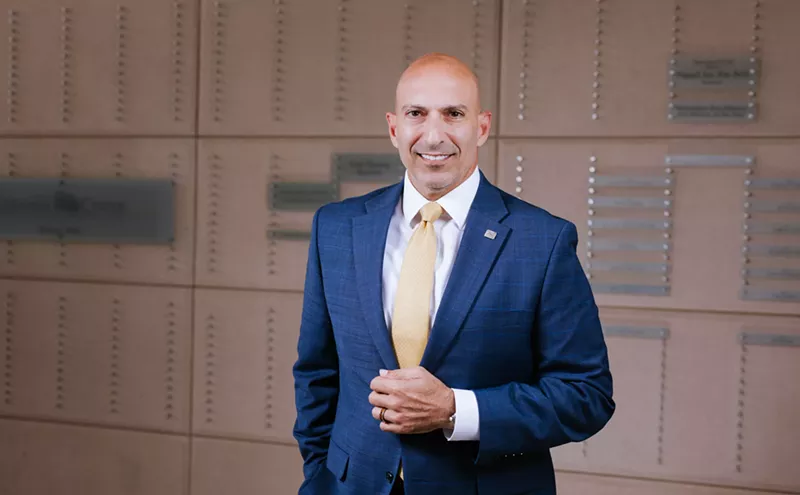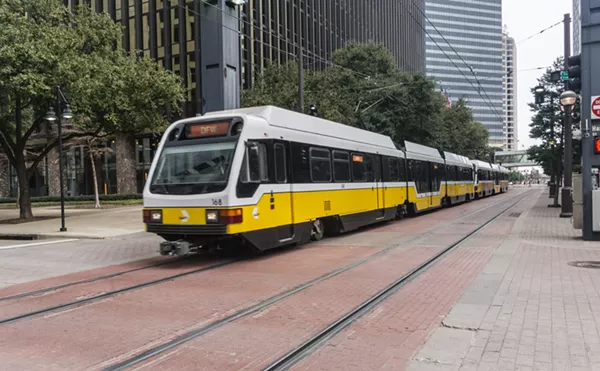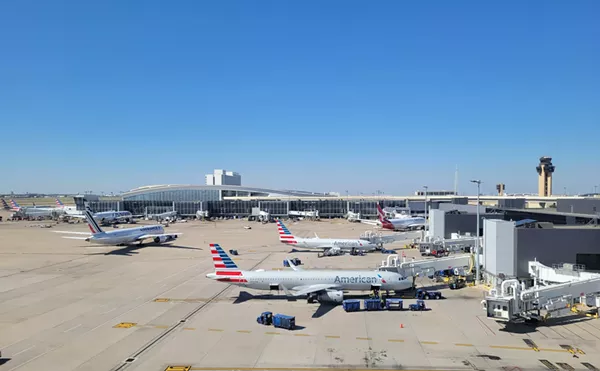Last week in a Dallas City Council session someone suggested that maybe Dallas has fallen a bit behind in the race to become a primary continental shipping hub.
Yeah. You could say. Race started. Other guy took off. Crowd roaring. We're still stuck in the gate, and our jockey's drunk. I'd say we're behind. I'd say we're not in the race.
"We're probably maybe two years behind schedule," said council member Tennell Atkins, speaking of efforts to develop a major North American shipping hub in southern Dallas.
No, not two years. Five years. And the race doesn't go forever. There's a finish line coming up soon.
This is not pinochle. Ultimately it's not about shipping. This is urban life and death.
The worst thing? We're not behind by accident. This isn't a thing that just happened. It was done. The city's only daily newspaper joined hands with a so-called regional planning agency, a former mayor, a former City Council member and a current county commissioner under investigation by the FBI to do this to us.
The shipping thing is the technical inside story. Let me point you to the big story. This is about the city itself, the economy and future of Dallas.
In the last five years since we started losing this race, an enormous tide of wealth has poured into the region around the development that has been winning. Southern Dallas meanwhile remains bitterly impoverished, and the city has been fenced out of the explosive growth of the region.
This thing is a marker for everything that can and cannot happen in Dallas in the next 50 years. If we let ourselves lose this horse race, it means we can't win a horse race.
But to win it now? We'd have to put dynamite under our saddle and light it. So let's put dynamite under saddle and light it.
This may hurt.
In 2005 when southern Dallas entered this race, it came into it with huge advantages. The stakes were and are monumental. In 2014, a newly widened and deepened Panama Canal will begin delivering a whole new volume of Pacific Rim trade to the Caribbean Sea.
Some portion of that trade will come up from Houston by rail, looking for a warehousing and distribution hub. In 2005, the two best candidates for that hub were southern Dallas and the Alliance Airport/Logistics development east of Fort Worth. Of the two, southern Dallas had the edge.
Even without the new Panama trade, southern Dallas already is a hub or crossing point for rail lines and highways coming north from Mexican deep-water ports and east from Los Angeles/Long Beach, then going east to Atlanta, north to Chicago and northeast to the main crossing point for freight into Canada at Detroit.
Why? It goes way back to a history Dallas has forgotten. We were a principle "logistics hub," although they didn't call it that, in the 19th century, a shipping point for goods flowing south and west and for commodities moving north and east. The roads and the railroads aren't here by accident. We just forgot why they're here.
The developers of the southern Dallas Inland Port project remembered. They also saw that the competing Alliance Logistics center developed by the Perot family interests north of Fort Worth lacked these advantages. Alliance was already under way and had a good head start on Dallas, but it was in the wrong place, cut off from the roads and rail lines that crisscross southern Dallas.
Ross Perot Jr. saw it. In October 2006, in a speech at the Fort Worth Chamber of Commerce, Perot, chief executive officer of the company that controls Alliance, described the Dallas Inland Port as "a direct threat" to his own holdings.
In June the following year, Tom Leppert celebrated his mayoral victory at a closed party in Perot's downtown Dallas penthouse suite, after winning the election with black votes brought to him by County Commissioner John Wiley Price. Soon afterward, Leppert and The Dallas Morning News began campaigning for an entire new planning process for the Inland Port, which effectively brought development to a halt. They were joined in this effort by the North Central Texas Council of Governments, but their most effective ally in bringing the Inland Port to its knees was Price.
As we now know based on FBI court files, a Price political operative with a history of close association with the Perot interests was cashing checks from Perot's company in close proximity to the times Price was introducing measures designed to cripple the Inland Port — in one instance the very same day.
The so-called "planning process" had the effect of telling potential clients that everything about the Inland Port was still up in the air and that investing in it would be a big gamble until the process ended.
Guess what. The stupid process hasn't ended yet. They're still planning five years later. And this is in spite of the fact that the main developer had completed five years of planning before this idea for more planning ever came up.
This isn't planning. It's a monkey wrench. And it's still going on. This "planning" championed by the News, Leppert, Price, former council member Ron Natinsky and the NCTCOG brought land sales and leases in the Inland Port to a halt in the year before the national economy went into severe recession. The main developer of the Inland Port was forced into a bankruptcy, from which that company has now emerged.
At last week's council meeting, city staff blamed the extreme loss of momentum in the Inland Port on the developer's bankruptcy and the recession. First of all, blaming the developer for his bankruptcy is like hitting the guy over the head, taking his wallet and then criticizing him for not having more money. And what about that recession? How did it affect the area around Alliance?
Using data from 2010, The Gadberry Group, a market research firm specializing in tracking affluent ZIP codes, last year published a study that described Haslet, a town near Alliance, as the nation's second hottest wealth-building location, driven largely by Alliance. Nearby Keller was the third fastest growing in the country.
The U.S. Census Bureau reported that average household income in Haslet in 2010 was $87,140. Gadberry used its own data and algorithms to deduce that more than 300 millionaires lived in the immediate Haslet area in 2010 and that average household net worth in 2010 was $222,833.
Between the 2000 and 2010 censuses, Fort Worth itself grew by 200,000 residents, a growth rate of 38.8 percent, making it the fastest growing city of more than 500,000 people in the nation.
In that same period from 2000 to 2010, Dallas grew by 9,276 persons for a growth rate of 0.8 percent. Fort Worth's growth rate was 48 times that of Dallas.
In the last decade, Dallas County grew by 149,240 souls, according to the census, for a rate of 6.7 percent. So, of those people who did decide to come live in Dallas County, 139,964 elected not to live in the city of Dallas. Of the newcomers, 94 percent settled outside the city.
Let's look more closely at the area of the Inland Port in southern Dallas. The analyses available in 2006 when this conversation got going found that the Inland Port development, fully realized, would produce 60,000 new well-paid jobs with benefits in southern Dallas.
I looked at an analysis published by the Mayor's Southern Dallas Task Force of the three census reporting tracts where all of that growth would have taken place had it not been for the successful campaign to stymie it. The first census tract in Pleasant Grove has fewer than 10,000 jobs for almost 100,000 people, half of whom have less than a high school education. Per capita income is less than $12,000 a year.
I could walk us through the other two tracts, but you get the picture. I can get tears in my eyes looking at this stuff. Southern Dallas has got some bums in the alleys, but it also has hungry, ambitious, bright-eyed, young people looking for a shot. At least they're bright-eyed for a while. Then they find out they don't have a shot, and those bright eyes go hard and dull.
This was a shot that was taken away from them. It didn't just fly away. It didn't die on its own. People killed it. John Wiley Price killed it. Tom Leppert killed it. The Dallas Morning News killed it.
But if we spend all our time thinking about all that crap, we're just killing ourselves even worse, doing it to ourselves. Here's the thing: It ain't over. The basic advantage is still there. The highways didn't go away. Nobody has ripped up the train tracks yet, although NCTCOG is working as hard as it can to jam them up with passenger rail, which will be the same thing as ripping them up. If NCTCOG gets away with that, all of our rail will be useless for freight, and Perot's up around Alliance will be built of bars of gold.
This gets us back to the dynamite in the saddle, the part that may hurt. When Leppert effectively killed the Inland Port, he did it in part by taking it away from the City Council, where it had strong champions, and putting it "in-house," as a staff assignment for city bureaucrats.
To get this thing up and running again, it will have to be surgically removed from City Hall and given to somebody outside, somebody big, somebody national. It needs to be in the hands of somebody who can pick up a phone, get a senator or congressman or top White House policy person on the other end of the line and start talking shop without too much hello.
I think the surgery should be performed without benefit of anesthetic. But that's just me. The main thing is to get it done. Right about now.











